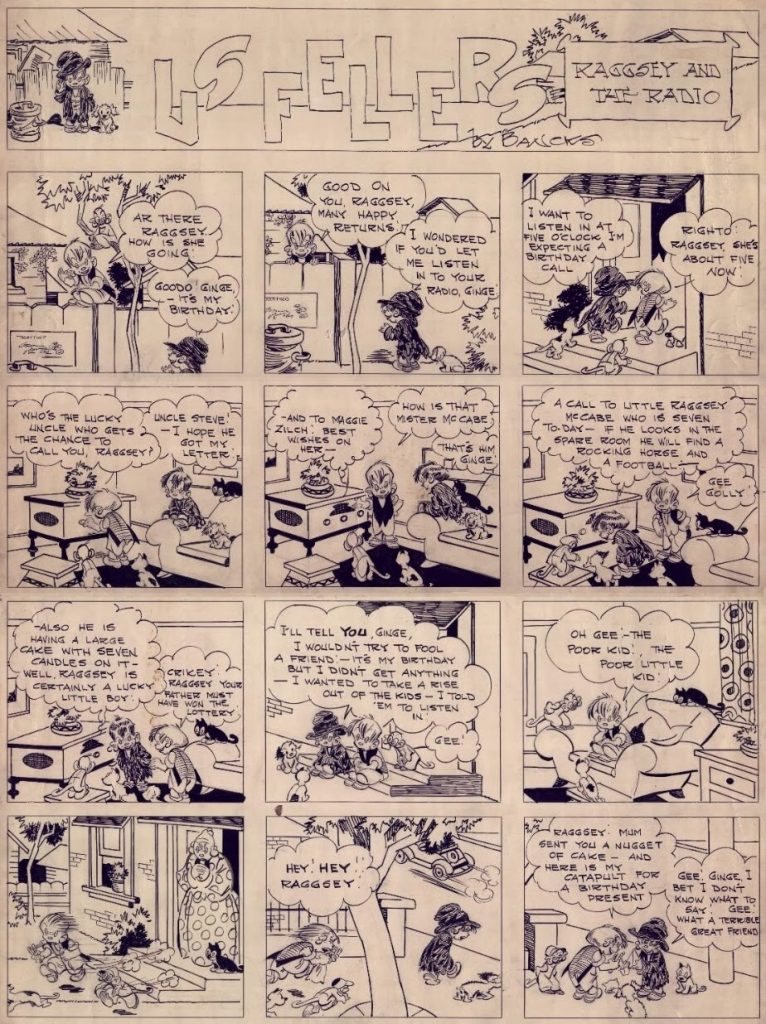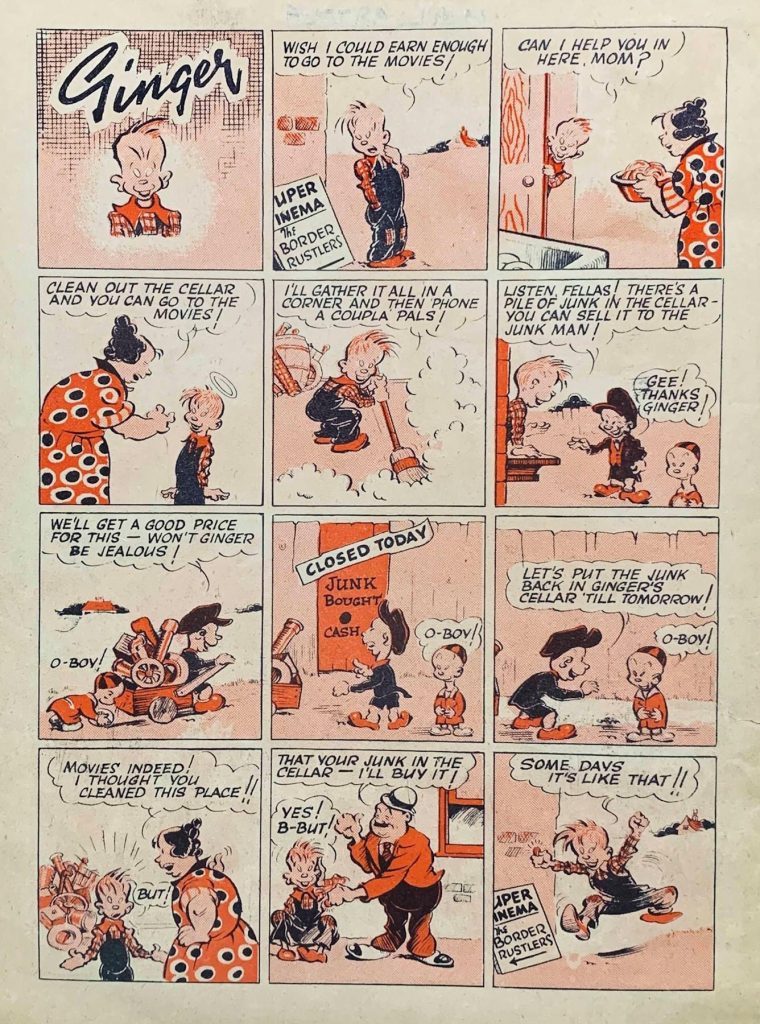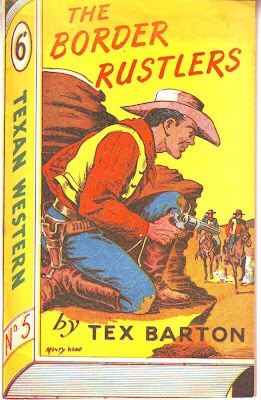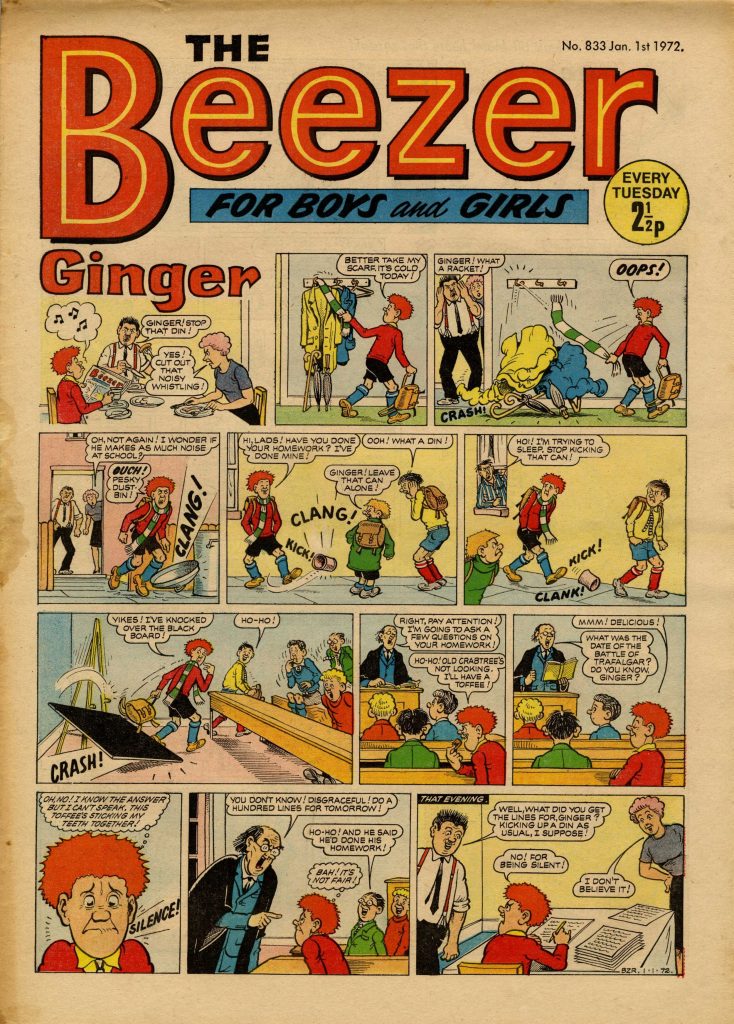A downthetubes reader threw us a query about a mystery strip called, simply, “Ginger”, which seems to have been inspired by “Ginger Meggs”, Australia’s most popular and longest-running newspaper strip – but was it a British or American creation, or was it published in some other primarily English-speaking country?
Please note – this article now includes an update to the original post, answering many questions about the strip’s origin

“Ginger Meggs”, which follows the escapades of a red-haired prepubescent mischief-maker, was first published one hundred years ago this month and is still going strong, today, created by Jimmy Bancks, first appearing as “Ginger Smith” in the Sydney Sunday Sun, in the strip, “Us Fellers”, on 13th November 1921.

After Bancks sudden death of a hear attack in 1952, after a year of reprints the strip was taken over by Ron Vivian (1953-1973), followed by Lloyd Piper (1973-1982), James Kemsley (1983-2007) and, since 2007, Jason Chatfield.
The latest strips, available to read on GoComics, see Jason celebrating the strip’s creators down the decades during the character’s 100th anniversary month.

The mystery “Ginger” strip comes to us via Australian journalist and cartoonist Lindsay Foyle, who came across the strip minus any credits or source, and as a fan of “Ginger Meggs”, had him wondering where it was published.
The star of the mystery “Ginger” strip bears an uncanny resemblance to “Ginger Meggs”, and the format suggests it might have appeared in a British comic, although the language – particularly the use of “Mom”, “junk”, and “movies” – suggests it might be American in origin.

The strip has left British comic experts scratching their collective heads, but Lew Stringer has suggested that as it’s two tone, it might be a strip produced for the inside over of an American comic.
“Some did use things like that in the Golden Age,” he notes. “I think it’s a British strip imitating American comics though, as many did in the 1950s for UK small publishers, like Swan. The art style of the man in the penultimate panel is very British in the way he’s drawn.”
Another suggestion we were offered is that it’s the work of an Australian cartoonist trying their hand in the American market, perhaps even one of the “Ginger Meggs” artists, although, it seems unlikely given the wide syndication of the strip itself, which even in today’s sadly much diminished market, is still appearing in over 120 newspapers, in 34 countries.
If “Ginger” was a try out for a comic, an attempt to deliver the widely syndicated “Ginger Meggs” in a new format, you would surely expect some kind of licensing acknowledgment on the strip.

Could there be a clue in the movie “Ginger” wants to see? A quick online search doesn’t turn up The Border Rustlers as a film title, it is the title of a western adventure, published by Sydney-based The Whitman Press, published in the early 1950s, the cover drawn by Monty Wedd, best known for his fantastic historical strips such as “Ned Kelly” and the masked vigilante Captain Justice, who fought bushrangers and ”righted all wrongs” in colonial New South Wales.
To be clear, there is absolutely no suggestion here that “Ginger” is the work of Wedd, but could the film featured be an unconscious nod to the book, and therefore further indicate “Ginger” is the work of an Australian creator?
(Also in the ring is “Gene Autry and the Border Rustlers”, a story published in Gene Autry Comics #88 by American publisher Dell, in 1954, but that seems really tenuous!)
An Update: The Mystery (Partly) Solved!

UPDATE: Thanks to comics expert Jeff Battista, we can now report the strip featured in the British title The RoundUp Budget of Fun and Adventure – 1948 published by Mallard Features/The Children’s Press, based in Glasgow, featured in a post to the Facebook New Zealand Comics Group.
“Ginger” rubbed shoulders with cowboy stories such as “Stryke Saunders”, “Quicksilver, The Wonderman of the West” and “Grant Ross, Circus Ace”.
Steve Holland, who runs the brilliant Bear Alley web site, tells us The Children’s Press was an imprint of Glasgow-based Collins, and used on many children’s books. They produced half a dozen comics in 1947-48, almost all produced by McCail’s Mallard Features.
Collector and comics archivist Peter Hansen tells us “Ginger Meggs” annuals were available in the UK before World War Two, which may be the “inspiration” for this mystery strip.
The Possible Artist?
“It’s likely to have been drawn by one of those humour artists who worked for Bill and Jock McCail at their Livingston and Mallard Studios in Scotland (Dundee and Glasgow) after leaving DC Thomson to set it up,” Peter Hansen says.
“Mallard Studios was set up at the beginning of the war, after they left DC Thomson in Dundee, in Glasgow, with Len Fullerton who was also a DCT artist, but signed his moniker as ‘Nat Brand’. He also drew a lot of nature studies for comics.”
“So it’s likely to be the great Mr. Samual Robert Fair, known as Sam Fair, who did humour strips for The Beano as a freelance artist, rather than, say, the well known straight artists like Alf Farningham who drew Sci-fi, and adventure strips such as those in the Meteor comic they published,” he suggests.
“Sam lived in Dundee, had the experience and the ability to create this strip for a comic that was full of DC Thomson ex-staff!! And had a track record of working with other small publishers.

“Sam started off working for DCT’s boys papers during the 1930s, which is likely where he met met the brothers,” Peter continues. “He certainly did his fair share during the war after going freelance working for the small press during the wartime/post wartime era, including stories such as “Halcon, Lord of the Craters” which appeared in All Fun and Comic Capers, and other strips for Soloway, also “Crash Carew, Daredevil of the Stratosphere” (Comic Capers and Comic Adventures), and “Dandy McQueen of the Royal Mounted” in All Star, Comic Adventures, and Red Star Comic etc.”
“He drew ‘Musso’ [title shortened here – Ed], ‘Addie And Hermy’, and ‘Pansy Potter’ for DC Thomson during the war, and went on to work for the Eagle, Lion, Buster and TV Comic.
“The studio also included Colin Andrew, George Blow, and Sydney Jordan, and there could have been more. But in my opinion Sam is my bet!”
One Last Mystery?
However, despite finding the source, and possible artist, the strip still begs the question – was “Ginger”, erm, simply “nicked”, or was an international arrangement struck? We rather suspect the former!
Web Links
• More about Ginger Meggs online at www.gingermeggs.com
• Read “Ginger Meggs” on GoComics
• Celebrating 100 years of the iconic character and Aussie legend Ginger Meggs, a new book, Bancks’ Ginger Meggs offers four brand new and original stories about the character, written by Tristan Bancks, the great-great nephew of creator Jimmy Bancks, and illustrated in full colour by the current “Ginger Meggs” comic-strip cartoonist, Jason Chatfield.
• Ginger Meggs Park, in Hornsby, New South Wales, was named in 1927 in honour of cartoonist Jimmy Bancks, the creator of the Ginger Meggs character. Jimmy spent much of his childhood in the area. The park is located in Valley Road, adjacent to a creek that was named Jimmy Bancks Creek
• Lindsay Foyle is a former deputy editor of The Bulletin and a past president of the Australian Cartoonists’ Association. He has been working on The Australian and contributes cartoons to the paper for over a decade, and is also a contributor to The New Matilda
• Sydney Morning Herald tribute to Monty Wedd
Ginger in The Beezer
“Ginger Meggs” or the mystery “Ginger” should not be confused with the long-running DC Thomson-owned “Ginger”, star of the long-running weekly The Beezer comic from its first issue, published in January 1956.
The character, originally created by Dudley D. Watkins, who drew the strip until his death in 1969, was the comic’s cover star until 1961, when “Pop, Dick and Harry” took over for a few years – but Ginger returned to the front cover in 1964.

After Watkins death, Bob McGrath drew “Ginger” until 1985, when he in turn was succeeded by Jimmy Glen, who drew the strip until The Beezer merged with The Topper in 1990. Nick Brennan drew the strip in the later Beezer annuals, and Ken H. Harrison drew him on covers for the monthly Classics from the Comics.
Ginger Meggs™ is a registered Trademark of Winslow Investments Pty Ltd
With thanks to to Timothy Benson for starting me down this rabbit hole; and, latterly, Jeff Batista, Lew Stringer, and Peter Hansen, and all who offered suggestions – much appreciated
The founder of downthetubes, which he established in 1998. John works as a comics and magazine editor, writer, and on promotional work for the Lakes International Comic Art Festival. He is currently editor of Star Trek Explorer, published by Titan – his third tour of duty on the title originally titled Star Trek Magazine.
Working in British comics publishing since the 1980s, his credits include editor of titles such as Doctor Who Magazine, Babylon 5 Magazine, and more. He also edited the comics anthology STRIP Magazine and edited several audio comics for ROK Comics. He has also edited several comic collections, including volumes of “Charley’s War” and “Dan Dare”.
He’s the writer of “Pilgrim: Secrets and Lies” for B7 Comics; “Crucible”, a creator-owned project with 2000AD artist Smuzz; and “Death Duty” and “Skow Dogs” with Dave Hailwood.
Categories: Comics, Creating Comics, downthetubes Comics News, downthetubes News, Events
 Portsmouth Comic Con announces 2024 Talent Search
Portsmouth Comic Con announces 2024 Talent Search  Upcoming comic artist Denzell Dankwah guest at Cheltenham’s Fine Lines Illustration and Animation Festival
Upcoming comic artist Denzell Dankwah guest at Cheltenham’s Fine Lines Illustration and Animation Festival  Oxford Comics Network announces new season of free webinars
Oxford Comics Network announces new season of free webinars  Lakes International Comic Art Festival and VIP Brands Ltd. launch 2024 “Sophie Castille Award – English” for Comics in Translation
Lakes International Comic Art Festival and VIP Brands Ltd. launch 2024 “Sophie Castille Award – English” for Comics in Translation
Really doesn’t look like a USA comic, unless someone was giving it a deliberate non-USA look. Most of the professional US comics have been indexed as well. As the art appears professional, my guess would be a unsuccessful presentation by someone trying for a licensed Ginger comic. Every so often unpublished material shows up – too bad there’s no provenance for this page to add clarification.